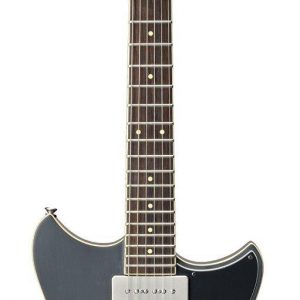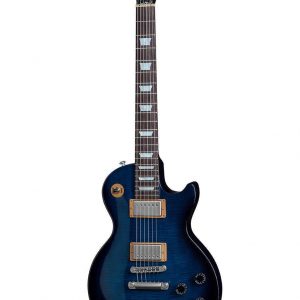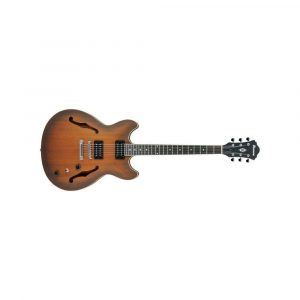Squier By Fender Mini Jazzmaster
$106.99
Get ready to rock with the Squier By Fender Mini Jazzmaster, the perfect guitar for beginners and experienced musicians alike!
Compare
Description
The Squier By Fender Mini Jazzmaster electric guitar is a compact, travel-sized version of the classic Jazzmaster. This guitar has become increasingly popular among beginner guitarists and players looking for a lightweight, highly portable instrument.
At just 22.75 inches in length, the Squier Mini Jazzmaster is perfect for smaller hands or players who prefer a shorter scale length. Despite its smaller size, this guitar still retains the iconic offset body shape and distinctive Jazzmaster style.
The guitar features a comfortable “C”-shaped neck, 20 medium jumbo frets, and a rosewood fretboard. It comes equipped with one humbucking pickup in the bridge position, controlled by a single volume knob and a three-way pickup selector switch.
One of the standout features of the Squier Mini Jazzmaster is its affordability. Retailing at a fraction of the cost of a full-sized Jazzmaster, this guitar is a great option for players on a budget who still want to experience the unique sound and style of the iconic guitar.
The Mini Jazzmaster is also a popular choice for young players or beginners, due to its lightweight and easy-to-play design. But it’s not just for beginners – the Mini Jazzmaster has been used by musicians across genres and skill levels, from indie rock to jazz.
With its smaller size, lightweight design, and affordable price tag, the Squier By Fender Mini Jazzmaster is a great option for anyone looking for a compact guitar that doesn’t compromise on sound quality or style. Whether you’re a seasoned player or brand new to the instrument, the Mini Jazzmaster is a versatile and accessible guitar that’s worth considering.
Squier By Fender Mini Jazzmaster properties
| Product name |
Mini Jazzmaster |
| Brand |
Squier By Fender |
| Type |
String Instruments |
| String Instruments |
Electric Guitar |
| Number of Strings |
6 pcs |
| Handedness |
Right-handed |
| Number of Frets |
20 |
| Cutaway |
Single Cutaway |
| Wood Type (body sides) |
Poplar |
| Wood Type (neck) |
Maple |
| Wood Type (fretboard) |
Maple |
| Colour |
Blue, Green, White |
Frequently Asked Questions:
What are some recommended steps for setting up and adjusting my Squier by Fender Mini Jazzmaster electric guitar for optimal playability and tone?
Setting up and adjusting your Squier by Fender Mini Jazzmaster electric guitar can be a fun and rewarding experience. Here's how you can do it:
1. Gather the necessary tools: To properly set up your Mini Jazzmaster, you will need a truss rod wrench, nut driver or Allen key (usually 3mm), phillips head screwdriver, guitar strings, and a clean cloth. You may also want an electronic tuner to ensure accurate tuning throughout the process.
2. Remove the strings: Before starting any adjustments, remove all six strings from your Mini Jazzmaster. This will allow you to work more easily on the guitar's hardware.
3. Check the neck for straightness: Hold the fretboard against a straight edge and observe if there are any noticeable gaps between the two. If necessary, use the truss rod wrench to adjust the angle of the neck by turning it clockwise or counterclockwise. Make small adjustments at a time and check regularly until you achieve optimal alignment.
4. Set string height: Adjust the bridge saddles to achieve the desired action (the distance between the strings and the fretboard). You can do this by loosening the locking nuts on either side of the bridge, then moving the saddles up or down as needed. Tighten the locking nuts again after making your adjustments.
5. Set intonation: Using a tuner, check that each open string produces the correct pitch. To adjust intonation, loosen the strings at the saddle, slide them forward or backward to align with the 12th fret harmonic, then retighten the strings. Repeat this process for all six strings and re-tune your guitar.
6. Reset the truss rod: After completing neck adjustments, use a phillips head screwdriver to loosen the truss rod cover on the back of the headstock. Turn the adjustment wheel clockwise or counterclockwise (depending on whether you need to relieve or increase tension) until it matches your desired action. Tighten the truss rod cover and retune your guitar.
7. Reinstall strings: Carefully thread each new string through its corresponding tuner post, then pull it taut and secure it by winding around the post. Repeat for all six strings.
8. Final adjustments: Once all six strings are installed, tune your Mini Jazzmaster to standard pitch (E-A-D-G-B-E). Play through each fret on every string, checking for any buzzing or fret rattle. Make minor truss rod adjustments if necessary.
9. Finishing touches: Clean your guitar with a soft, dry cloth to remove any dirt or debris that may have accumulated during the setup process. Your Squier by Fender Mini Jazzmaster is now ready for optimal playability and tone!
How does the modified pickup configuration on the Squier By Fender Mini Jazzmaster impact its tonal versatility compared to traditional Jazzmaster guitars?
The modified pickup configuration on the Squier By Fender Mini Jazzmaster, featuring dual single-coil pickups instead of the typical Jazzmaster humbuckers, provides a brighter and more transparent sound that is well-suited for clean playing and chimey jangle. The single-coil pickups allow for greater clarity and definition in each note, making it easier to distinguish between individual strings and notes within chords or melodic lines. Additionally, the absence of humbuckers means that there is less low-end frequency response, which can be an advantage for players who prefer a more focused and controlled sound. While this modified configuration may not have the same thick and full-bodied tone as traditional Jazzmaster guitars, it offers a unique tonal character that is appealing to certain styles of music such as indie rock or jangle pop. Ultimately, the choice between the two configurations will depend on the player's personal preference and intended musical application.
What are the unique features of the Squier by Fender Mini Jazzmaster electric guitar and how do they contribute to its overall sound and playability?
The Squier by Fender Mini Jazzmaster electric guitar boasts several distinctive features that set it apart from other guitars in its class. Firstly, its compact size, measuring just 31 inches in length, makes it an ideal choice for players with smaller statures or those looking for a more portable option. Despite its diminutive dimensions, the Mini Jazzmaster boasts a full-size scale length of 24 inches, ensuring that it is still capable of producing rich, resonant tones. Another standout feature of this guitar is its dual single-coil pickups, which are mounted in an asymmetrical configuration. This layout provides players with a versatile range of sounds, from bright and crisp to warm and mellow. The pickups also feature classic Fender design elements, such as alnico magnets and vintage-style cloth covered wiring, further contributing to the Mini Jazzmaster's authentic Fender tone. In addition to its sonic capabilities, the Squier by Fender Mini Jazzmaster is also designed with playability in mind. Its slim "C"-shaped neck profile and 20-fret fingerboard make it comfortable and easy to navigate, while its vintage-style tuners ensure precise intonation and tuning stability. The guitar's bridge design, which incorporates a traditional Jazzmaster-style vibrato system, also allows for expressive and dynamic playing techniques. Overall, the unique features of the Squier by Fender Mini Jazzmaster contribute to its distinctive sound and playability, making it an excellent choice for both beginners and experienced musicians alike. Whether you are looking to add a compact and versatile guitar to your collection or simply want to explore the world of Fender-style music-making, the Mini Jazzmaster is definitely worth considering.
What are the unique features of the Squier By Fender Mini Jazzmaster electric guitar and how do they differ from a standard Jazzmaster model?
The Squier By Fender Mini Jazzmaster electric guitar stands out with its compact size, measuring in at 3/4 scale. This makes it an excellent option for younger players or those who prefer a more portable instrument. In terms of other unique features, the Mini Jazzmaster boasts a slim neck profile and a shorter 24" scale length, which can make playing more comfortable for beginners or those transitioning from smaller guitars. While the standard Jazzmaster model also has a distinctive offset body shape, the Mini Jazzmaster's version is slightly smaller and more condensed. The pickups on this guitar are also different, with single-coils replacing the traditional Jazzmaster humbuckers, resulting in a brighter, more articulate sound that's well-suited for a variety of genres. Overall, the Squier By Fender Mini Jazzmaster offers an exciting take on a classic design that combines familiar features with fresh updates that make it stand out as a unique and versatile instrument.
Before you buy Squier By Fender Mini Jazzmaster
 Yamaha Revstar RS320
Yamaha Revstar RS320  Yamaha Revstar RS502
Yamaha Revstar RS502 









Reviews
There are no reviews yet.